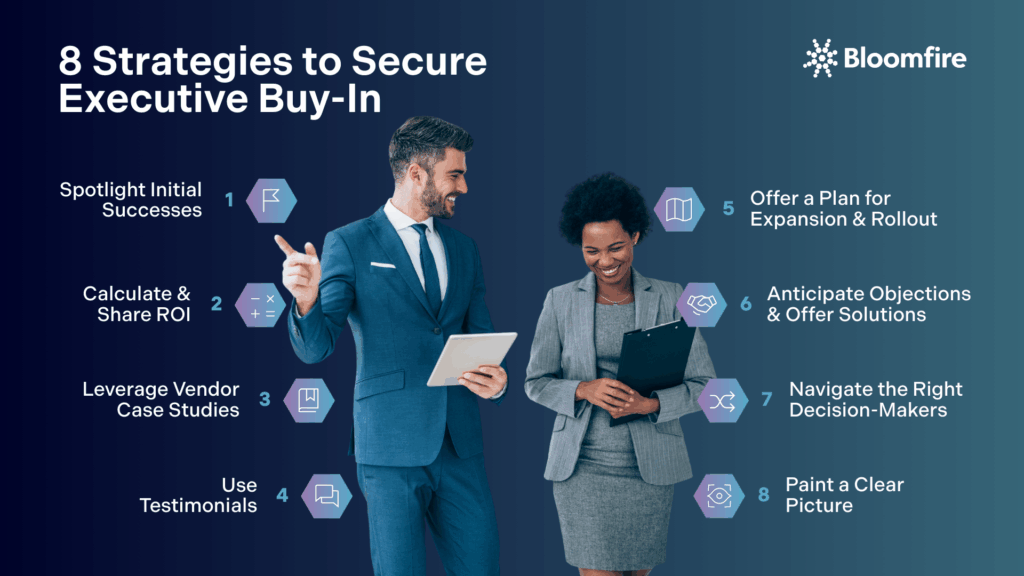How to Navigate the Chain of Command in Business to Get Executive Buy-in

You’re starting to see results and positive ROI from your knowledge engagement platform. Maybe your team members reduced the time they spend searching for information every day by half an hour, or you’ve seen a significant decrease in internal emails and phone calls now that everyone has one place to find departmental knowledge.
Given these successes, you believe that other departments—and potentially the entire organization—could benefit from company-wide adoption of your knowledge engagement platform.
8 Strategies to Secure Executive Buy-In
Gaining executive buy-in to expand your knowledge engagement platform requires a thoughtful approach. You’ll need to present a clear case that aligns with business goals, showcases measurable success, and demonstrates the long-term value of scaling the platform. The following eight strategies will help you effectively communicate your platform’s impact and win support from leadership.

1. Spotlight Initial Successes
The first step in getting executive buy-in is showing the platform’s tangible impact. Share the metrics highlighting time savings, improved collaboration, and more efficient workflows. For example, a customer support team might demonstrate how reps now resolve questions faster, leading to improved customer satisfaction. Metrics like these tie directly into business outcomes executives care about.
However, don’t stop at metrics. Position your knowledge engagement platform as part of a strategic initiative. Explain how the successes in one department can be replicated across the organization to scale impact. This will position you as someone who understands how to align departmental wins with broader business goals.
2. Calculate and Share ROI
To gain executive support, present a compelling case grounded in return on investment (ROI). Highlighting process improvements and efficiencies is effective, but complex numbers and their financial implications will substantially impact them.
Here’s how to calculate and present ROI:
Productivity Improvements
Quantifying productivity gains is crucial. For example, a contact center that has seen a reduction in time-to-resolution (TTR) can compare TTR metrics month-over-month and year-over-year. You provide tangible evidence of improved performance by showing that call times have shortened and the team handles more calls. Similarly, measure the time employees spend searching for information before and after implementing the platform to estimate labor savings. This data illustrates how your department can take on more work with the same headcount, a key concern for executives.
Onboarding Improvements
Onboarding is a costly yet necessary process. A knowledge engagement platform can streamline this by consolidating training materials and reducing new employees’ time to reach total productivity. Calculate cost savings by comparing the training time before and after platform implementation.
Employee Engagement
According to the Society for Human Resource Management (SHRM), the average position in the U.S. takes about 42 days to fill and costs approximately $4,129. When factoring in a vacancy’s potential one-month salary cost, the total expense can exceed $5,000. Retaining your existing employees is crucial, as it is significantly more cost-effective than hiring and training new ones. Implementing a knowledge engagement platform enhances employee autonomy and confidence, increasing job satisfaction.
3. Leverage Vendor Case Studies
In addition to sharing your team’s successes, back up your case by referencing similar use cases from your knowledge engagement platform vendor. If you’re advocating for an expansion into sales, marketing, or product teams, look for vendor case studies that show how other companies have implemented the platform across these functions.
Executives often want proof that what works in one department can work across the entire organization. Providing case studies from companies in the same industry or companies that faced similar challenges demonstrates that your proposal is based on proven success, not just speculation.
If case studies aren’t readily available on the vendor’s website, don’t hesitate to contact them directly. They may be able to share success stories that closely align with your goals or connect you with customers who have gone through a similar process.
4. Use Testimonials to Support Your Proposal
Data is essential, but adding a human element will make your proposal more relatable. If your team has taken pre- and post-implementation surveys, share the results to show efficiency, job satisfaction, or productivity improvements. Better yet, collect testimonials from team members who use the platform every day. Real-world stories from your team about how the knowledge platform has changed their work will bring your pitch to life.
For an even more powerful impact, consider including video testimonials. Executives are more likely to remember your proposal if it’s reinforced with personal accounts delivered through a medium that captures emotion, tone, and enthusiasm. Testimonials can bridge the gap between raw data and day-to-day realities, making your case even more compelling.
5. Offer a Plan for Expansion and Rollout
Demonstrating a plan for how you’ll roll out the platform to other departments is critical to easing concerns about adoption. Offer to host a roadshow where you demo the platform for different departments. Show how the platform can integrate with their existing processes and help solve their specific challenges:
- Show each department how the knowledge engagement platform will benefit them
- Demonstrate how the platform can fit into (and enhance) existing processes
- Prepare departments for the upcoming rollout
- Get feedback from team members
- Use that feedback to optimize the knowledge engagement platform structure
This approach not only helps departments visualize how the platform will benefit them, but it also gives you a chance to collect feedback from potential end users. A successful roadshow will excite departments about the platform ahead of the expansion, increasing the likelihood of adoption and reducing pushback from leadership.
6. Anticipate Objections and Offer Solutions
One key to getting executive buy-in is proactively addressing objections. Sales leaders recommend bringing up objections before the prospect does, and you can apply this strategy when presenting your case to executives. Anticipate common objections, such as budget constraints or concerns about integration with other systems, and come prepared with solutions.
For example, if your legal team needs a platform to share sensitive information, suggest setting up a separate community store to access confidential data without compromising security. If executives are concerned about the cost, return to your ROI calculations and demonstrate how the platform will pay for itself in the long run.
7. Navigate the Right Decision-Makers
One often overlooked aspect of securing executive buy-in is navigating the chain of command in business. While you might have a champion in your department or at a middle management level, getting executive buy-in often requires endorsements from several decision-makers.
Consider starting your advocacy with a senior manager or director who has experienced the platform’s benefits firsthand. Once you have their support, ask them to help you present your case to the C-suite. Building a coalition of supporters who can speak to different benefits—reducing operational costs, streamlining communication, or enhancing employee engagement—will improve your chances of securing approval.
8. Paint a Clear Picture with Real-World Examples
Finally, tie it all together by painting a complete picture of how expanding the platform could look. Share a case study of a real-world example of a company successfully expanding its knowledge engagement platform. For instance, HR management firm Insperity centralized knowledge across its organization, starting with sales and later rolling out to other departments. This strategic expansion improved efficiency and engagement, ultimately securing ongoing support from senior leaders.
Navigating the Chain of Command in Business to Secure Executive Buy-In
Navigating the chain of command in business is essential to expanding your knowledge engagement platform across the organization. Present your case with clear ROI, relevant use cases, and a well-structured plan for rollout. By aligning your proposal with company goals, you’ll secure executive buy-in and drive lasting value across all departments.
Build a Business Case for KM
Download the toolkit you need to justify your knowledge management investment.
Download Now

Enterprise AI Search: Definition, Benefits, and Evolution

The Benefit of Company-Wide Knowledge Management in 2026

Are You Making These Common Knowledge Sharing Mistakes?

Estimate the Value of Your Knowledge Assets
Use this calculator to see how enterprise intelligence can impact your bottom line. Choose areas of focus, and see tailored calculations that will give you a tangible ROI.

Take a self guided Tour
See Bloomfire in action across several potential configurations. Imagine the potential of your team when they stop searching and start finding critical knowledge.
